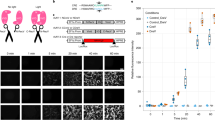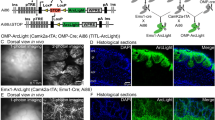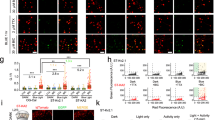Abstract
Identifying the neuronal ensembles that respond to specific stimuli and mapping their projection patterns in living animals are fundamental challenges in neuroscience. To this end, we engineered a synthetic promoter, the enhanced synaptic activity–responsive element (E-SARE), that drives neuronal activity–dependent gene expression more potently than other existing immediate-early gene promoters. Expression of a drug-inducible Cre recombinase downstream of E-SARE enabled imaging of neuronal populations that respond to monocular visual stimulation and tracking of their long-distance thalamocortical projections in living mice. Targeted cell-attached recordings and calcium imaging of neurons in sensory cortices revealed that E-SARE reporter expression correlates with sensory-evoked neuronal activity at the single-cell level and is highly specific to the type of stimuli presented to the animals. This activity-dependent promoter can expand the repertoire of genetic approaches for high-resolution anatomical and functional analysis of neural circuits.
This is a preview of subscription content, access via your institution
Access options
Subscribe to this journal
Receive 12 print issues and online access
$259.00 per year
only $21.58 per issue
Buy this article
- Purchase on Springer Link
- Instant access to full article PDF
Prices may be subject to local taxes which are calculated during checkout





Similar content being viewed by others
Change history
19 September 2013
In the version of this article initially published, the schema shown in Figure 5a was wrong. The error has been corrected in the HTML and PDF versions of the article.
References
Guzowski, J.F., McNaughton, B.L., Barnes, C.A. & Worley, P.F. Environment-specific expression of the immediate-early gene Arc in hippocampal neuronal ensembles. Nat. Neurosci. 2, 1120–1124 (1999).
Ramírez-Amaya, V. et al. Spatial exploration-induced Arc mRNA and protein expression: evidence for selective, network-specific reactivation. J. Neurosci. 25, 1761–1768 (2005).
Tse, D. et al. Schema-dependent gene activation and memory encoding in neocortex. Science 333, 891–895 (2011).
Schilling, K., Luk, D., Morgan, J.I. & Curran, T. Regulation of a fos-lacZ fusion gene: a paradigm for quantitative analysis of stimulus-transcription coupling. Proc. Natl. Acad. Sci. USA 88, 5665–5669 (1991).
Barth, A.L., Gerkin, R.C. & Dean, K.L. Alteration of neuronal firing properties after in vivo experience in a FosGFP transgenic mouse. J. Neurosci. 24, 6466–6475 (2004).
Kawashima, T. et al. Synaptic activity-responsive element in the Arc/Arg3.1 promoter essential for synapse-to-nucleus signaling in activated neurons. Proc. Natl. Acad. Sci. USA 106, 316–321 (2009).
Grinevich, V. et al. Fluorescent Arc/Arg3.1 indicator mice: a versatile tool to study brain activity changes in vitro and in vivo . J. Neurosci. Methods 184, 25–36 (2009).
Eguchi, M. & Yamaguchi, S. In vivo and in vitro visualization of gene expression dynamics over extensive areas of the brain. Neuroimage 44, 1274–1283 (2009).
Okuno, H. et al. Inverse synaptic tagging of inactive synapses via dynamic interaction of Arc/Arg3.1 with CaMKIIβ. Cell 149, 886–898 (2012).
Koya, E. et al. Targeted disruption of cocaine-activated nucleus accumbens neurons prevents context-specific sensitization. Nat. Neurosci. 12, 1069–1073 (2009).
Liu, X. et al. Optogenetic stimulation of a hippocampal engram activates fear memory recall. Nature 484, 381–385 (2012).
Garner, A.R. et al. Generation of a synthetic memory trace. Science 335, 1513–1516 (2012).
Matsuda, T. & Cepko, C.L. Controlled expression of transgenes introduced by in vivo electroporation. Proc. Natl. Acad. Sci. USA 104, 1027–1032 (2007).
Montero, V.M., Brugge, J.F. & Beitel, R.E. Relation of the visual field to the lateral geniculate body of the albino rat. J. Neurophysiol. 31, 221–236 (1968).
Tagawa, Y., Kanold, P.O., Majdan, M. & Shatz, C.J. Multiple periods of functional ocular dominance plasticity in mouse visual cortex. Nat. Neurosci. 8, 380–388 (2005).
Mrsic-Flogel, T.D. et al. Homeostatic regulation of eye-specific responses in visual cortex during ocular dominance plasticity. Neuron 54, 961–972 (2007).
O'Connor, D.H., Peron, S.P., Huber, D. & Svoboda, K. Neural activity in barrel cortex underlying vibrissa-based object localization in mice. Neuron 67, 1048–1061 (2010).
Kitamura, K., Judkewitz, B., Kano, M., Denk, W. & Hausser, M. Targeted patch-clamp recordings and single-cell electroporation of unlabeled neurons in vivo . Nat. Methods 5, 61–67 (2008).
Margrie, T.W. et al. Targeted whole-cell recordings in the mammalian brain in vivo . Neuron 39, 911–918 (2003).
Akerboom, J. et al. Optimization of a GCaMP calcium indicator for neural activity imaging. J. Neurosci. 32, 13819–13840 (2012).
Zariwala, H.A. et al. A Cre-dependent GCaMP3 reporter mouse for neuronal imaging in vivo . J. Neurosci. 32, 3131–3141 (2012).
Ohki, K., Chung, S., Ch'ng, Y.H., Kara, P. & Reid, R.C. Functional imaging with cellular resolution reveals precise micro-architecture in visual cortex. Nature 433, 597–603 (2005).
Melnikov, A. et al. Systematic dissection and optimization of inducible enhancers in human cells using a massively parallel reporter assay. Nat. Biotechnol. 30, 271–277 (2012).
Patwardhan, R.P. et al. Massively parallel functional dissection of mammalian enhancers in vivo . Nat. Biotechnol. 30, 265–270 (2012).
Böer, U. et al. CRE/CREB-driven up-regulation of gene expression by chronic social stress in CRE-luciferase transgenic mice: reversal by antidepressant treatment. PLoS ONE 2, e431 (2007).
Yassin, L. et al. An embedded subnetwork of highly active neurons in the neocortex. Neuron 68, 1043–1050 (2010).
Bock, D.D. et al. Network anatomy and in vivo physiology of visual cortical neurons. Nature 471, 177–182 (2011).
Briggman, K.L., Helmstaedter, M. & Denk, W. Wiring specificity in the direction-selectivity circuit of the retina. Nature 471, 183–188 (2011).
Hama, H. et al. Scale: a chemical approach for fluorescence imaging and reconstruction of transparent mouse brain. Nat. Neurosci. 14, 1481–1488 (2011).
Chung, K. et al. Structural and molecular interrogation of intact biological systems. Nature 497, 332–337 (2013).
Tian, J. & Andreadis, S.T. Independent and high-level dual-gene expression in adult stem-progenitor cells from a single lentiviral vector. Gene Ther. 16, 874–884 (2009).
Miyoshi, H., Blomer, U., Takahashi, M., Gage, F.H. & Verma, I.M. Development of a self-inactivating lentivirus vector. J. Virol. 72, 8150–8157 (1998).
Nagai, T. et al. A variant of yellow fluorescent protein with fast and efficient maturation for cell-biological applications. Nat. Biotechnol. 20, 87–90 (2002).
Li, X. et al. Generation of destabilized green fluorescent protein as a transcription reporter. J. Biol. Chem. 273, 34970–34975 (1998).
Thiel, G., Greengard, P. & Südhof, T.C. Characterization of tissue-specific transcription by the human synapsin I gene promoter. Proc. Natl. Acad. Sci. USA 88, 3431–3435 (1991).
Imayoshi, I. et al. Roles of continuous neurogenesis in the structural and functional integrity of the adult forebrain. Nat. Neurosci. 11, 1153–1161 (2008).
Ageta-Ishihara, N. et al. Control of cortical axon elongation by a GABA-driven Ca2+/calmodulin-dependent protein kinase cascade. J. Neurosci. 29, 13720–13729 (2009).
Bito, H., Deisseroth, K. & Tsien, R.W. CREB phosphorylation and dephosphorylation: a Ca2+- and stimulus duration-dependent switch for hippocampal gene expression. Cell 87, 1203–1214 (1996).
Smith, R.H., Levy, J.R. & Kotin, R.M. A simplified baculovirus-AAV expression vector system coupled with one-step affinity purification yields high-titer rAAV stocks from insect cells. Mol. Ther. 17, 1888–1896 (2009).
Kalatsky, V.A. & Stryker, M.P. New paradigm for optical imaging: temporally encoded maps of intrinsic signal. Neuron 38, 529–545 (2003).
Isomura, Y., Harukuni, R., Takekawa, T., Aizawa, H. & Fukai, T. Microcircuitry coordination of cortical motor information in self-initiation of voluntary movements. Nat. Neurosci. 12, 1586–1593 (2009).
Acknowledgements
We thank R. Kotin (US National Institutes of Health), B. Davidson (University of Iowa) and I. Bezprozvanny (University of Texas Southwestern Medical Center) for original AAV vectors; S. Josselyn and P. Frankland for the in vivo viral injection protocol; H. Kawasaki for advice on LGN experiments; V. Ramirez-Amaya for advice on Arc detection; S. Andreandis (The State University of New York, Buffalo) for a cHS4 construct; C. Cepko (Harvard University) for an ERT2CreERT2 construct; T. Curran (University of Pennsylvania) for a c-fos promoter construct; I. Imayoshi (Kyoto University) for a loxP-flanked STOP construct; L. Looger (Howard Hughes Medical Institute, Janelia Farm) for a GCaMP5G construct; A. Miyawaki (RIKEN BSI) for a Venus construct; H. Miyoshi (RIKEN BRC) for a lentiviral construct; the Research Support Center of the Graduate School of Medical Sciences at Kyushu University for technical support; and Carl Zeiss Japan for access to an LSM780. We thank all of the members of the Bito and Ohki laboratories for support and discussion. We are particularly indebted to Y. Kondo, K. Saiki, R. Gyobu and T. Kinbara for assistance. This work was supported in part by grants-in-aid from the Japanese Ministry of Education, Culture, Sports, Science and Technology (MEXT) and Japan Society for the Promotion of Science (JSPS) (to K.K., M.N., M.K., H.O. and H.B.), the Strategic Research Program for Brain Sciences (to M.K.) as well as grants from CREST–Japan Science and Technology Agency (JST) (to K.O. and H.B.), the Strategic International Research Cooperative Program Japan-Mexico (SICPME-JST, to H.B.) and the Mitsubishi Foundation (to H.B.). T.K., K.S., M. N. and S.K. were supported by JSPS fellowships.
Author information
Authors and Affiliations
Contributions
T.K., K.K., H.O., K.O. and H.B. conceived the experiments. T.K. performed the in vitro characterizations, design of virus vectors and image analyses. T.K., K.S. and M.N. performed virus purifications and injections. K.K. and M.K. performed electrophysiological recordings, and T.K. and K.K. performed two-photon imaging experiments in the barrel cortex. T.K. and K.O. performed two-photon imaging experiments of the visual cortex. T.K. and H.O. performed histological analyses. S.K. and S.T.-K. provided help with reagents and animal management. T.K., H.O., K.O. and H.B. wrote the paper. H.B. supervised the entire project. All authors discussed and commented on the manuscript.
Corresponding author
Ethics declarations
Competing interests
The authors declare no competing financial interests.
Supplementary information
Supplementary Text and Figures
Supplementary Figures 1–11 (PDF 17157 kb)
Rights and permissions
About this article
Cite this article
Kawashima, T., Kitamura, K., Suzuki, K. et al. Functional labeling of neurons and their projections using the synthetic activity–dependent promoter E-SARE. Nat Methods 10, 889–895 (2013). https://doi.org/10.1038/nmeth.2559
Received:
Accepted:
Published:
Issue Date:
DOI: https://doi.org/10.1038/nmeth.2559
This article is cited by
-
Experience-dependent changes in affective valence of taste in male mice
Molecular Brain (2023)
-
Xiphoid nucleus of the midline thalamus controls cold-induced food seeking
Nature (2023)
-
Recording of cellular physiological histories along optically readable self-assembling protein chains
Nature Biotechnology (2023)
-
Chemogenetic inhibition of subicular seizure-activated neurons alleviates cognitive deficit in male mouse epilepsy model
Acta Pharmacologica Sinica (2023)
-
Repeated stress exposure leads to structural synaptic instability prior to disorganization of hippocampal coding and impairments in learning
Translational Psychiatry (2022)



